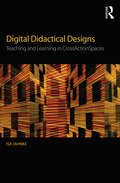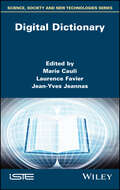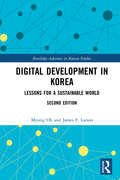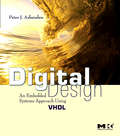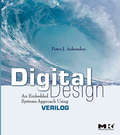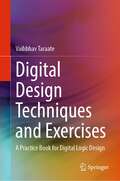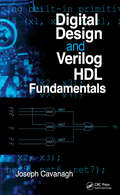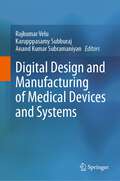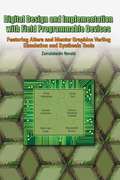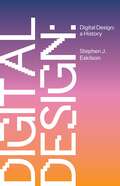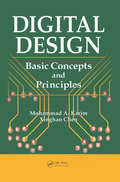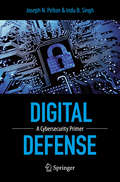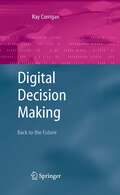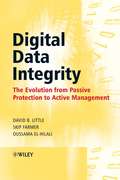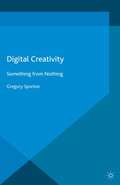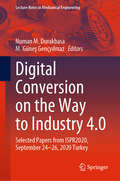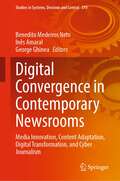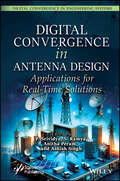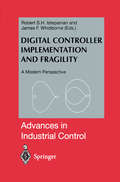- Table View
- List View
Digital Didactical Designs: Teaching and Learning in CrossActionSpaces
by Isa JahnkeAs web-enabled mobile technologies become increasingly integrated into formal learning environments, the fields of education and ICT (information and communication technology) are merging to create a new kind of classroom: CrossActionSpaces. Grounding its exploration of these co-located communication spaces in global empirical research, Digital Didactical Designs facilitates the development of teachers into collaborative designers and evaluators of technology-driven teaching and learning experiences—learning through reflective making. The Digital Didactical Design model promotes deep learning expeditions with a framework that encourages teachers and researchers to study, explore, and analyze the applied designs-in-practice. The book presents critical views of contemporary education, theories of socio-technical systems and behavior patterns, and concludes with a look into the conceptual and practical prototypes that might emerge in schools and universities in the near future.
Digital Dictionary
by Marie Cauli Laurence Favier Jean-Yves Jeannas"Digital age", "digital society", &“digital civilization&”: many expressions are used to describe the major cultural transformation of our contemporary societies.Digital Dictionary presents the multiple facets of this phenomenon, which was born of computers and continues to permeate all human activity as it progresses at a rapid pace. In this multidisciplinary work, experts, academics and practitioners invite us to discover the digital world from various technological and societal perspectives.In this book, citizens, trainers, political leaders or association members, students and users will find a base of knowledge that will allow them to update their understanding and become stakeholders in current societal changes.
Digital Dictionary
by Marie Cauli Laurence Favier Jean-Yves Jeannas"Digital age", "digital society", &“digital civilization&”: many expressions are used to describe the major cultural transformation of our contemporary societies.Digital Dictionary presents the multiple facets of this phenomenon, which was born of computers and continues to permeate all human activity as it progresses at a rapid pace. In this multidisciplinary work, experts, academics and practitioners invite us to discover the digital world from various technological and societal perspectives.In this book, citizens, trainers, political leaders or association members, students and users will find a base of knowledge that will allow them to update their understanding and become stakeholders in current societal changes.
Digital Development in Korea: Lessons for a Sustainable World (Routledge Advances in Korean Studies)
by Myung Oh James F. LarsonDigital Development in Korea explores the central role of digital information and communication technology in South Korea. Analyzing the role of ICT in green growth and sustainability, this new edition also demonstrates how concerns over public safety and the Olympic Games are shaping next generation digital networks. Presenting a network-centric perspective to contextualize digital development politically, economically and socially, as well as in relation to globalization, urbanization and sustainability, this book builds on fi rsthand experience to explain the formulation and implementation of key policy decisions. It describes the revolutionary changes of the 1980s, including privatization and color television and the thorough restructuring that created a telecommunications sector. It then goes on to explore the roles of government leadership, international development and education in affecting the diffusion of broadband mobile communication, before weighing up the positive and negative aspects of Korea’s vibrant new digital media. Seeking to identify aspects of the Korean experience from which developing countries around the world could benefi t, this book will be of interest to students, scholars and policymakers interested in communications technologies, Korean studies and developmental studies.
Digital Development in Korea: Lessons for a Sustainable World (Routledge Advances in Korean Studies)
by Myung Oh James F. LarsonDigital Development in Korea explores the central role of digital information and communication technology in South Korea. Analyzing the role of ICT in green growth and sustainability, this new edition also demonstrates how concerns over public safety and the Olympic Games are shaping next generation digital networks. Presenting a network-centric perspective to contextualize digital development politically, economically and socially, as well as in relation to globalization, urbanization and sustainability, this book builds on fi rsthand experience to explain the formulation and implementation of key policy decisions. It describes the revolutionary changes of the 1980s, including privatization and color television and the thorough restructuring that created a telecommunications sector. It then goes on to explore the roles of government leadership, international development and education in affecting the diffusion of broadband mobile communication, before weighing up the positive and negative aspects of Korea’s vibrant new digital media. Seeking to identify aspects of the Korean experience from which developing countries around the world could benefi t, this book will be of interest to students, scholars and policymakers interested in communications technologies, Korean studies and developmental studies.
Digital Design (VHDL): An Embedded Systems Approach Using VHDL
by Peter J. AshendenDigital Design: An Embedded Systems Approach Using VHDL provides a foundation in digital design for students in computer engineering, electrical engineering and computer science courses. It takes an up-to-date and modern approach of presenting digital logic design as an activity in a larger systems design context. Rather than focus on aspects of digital design that have little relevance in a realistic design context, this book concentrates on modern and evolving knowledge and design skills. Hardware description language (HDL)-based design and verification is emphasized--VHDL examples are used extensively throughout. By treating digital logic as part of embedded systems design, this book provides an understanding of the hardware needed in the analysis and design of systems comprising both hardware and software components. Includes a Web site with links to vendor tools, labs and tutorials.Presents digital logic design as an activity in a larger systems design contextFeatures extensive use of VHDL examples to demonstrate HDL (hardware description language) usage at the abstract behavioural level and register transfer level, as well as for low-level verification and verification environmentsIncludes worked examples throughout to enhance the reader's understanding and retention of the materialCompanion Web site includes links to tools for FPGA design from Synplicity, Mentor Graphics, and Xilinx, VHDL source code for all the examples in the book, lecture slides, laboratory projects, and solutions to exercises
Digital Design (Verilog): An Embedded Systems Approach Using Verilog
by Peter J. AshendenDigital Design: An Embedded Systems Approach Using Verilog provides a foundation in digital design for students in computer engineering, electrical engineering and computer science courses. It takes an up-to-date and modern approach of presenting digital logic design as an activity in a larger systems design context. Rather than focus on aspects of digital design that have little relevance in a realistic design context, this book concentrates on modern and evolving knowledge and design skills. Hardware description language (HDL)-based design and verification is emphasized--Verilog examples are used extensively throughout. By treating digital logic as part of embedded systems design, this book provides an understanding of the hardware needed in the analysis and design of systems comprising both hardware and software components. Includes a Web site with links to vendor tools, labs and tutorials.Presents digital logic design as an activity in a larger systems design contextFeatures extensive use of Verilog examples to demonstrate HDL (hardware description language) usage at the abstract behavioural level and register transfer level, as well as for low-level verification and verification environmentsIncludes worked examples throughout to enhance the reader's understanding and retention of the materialCompanion Web site includes links to tools for FPGA design from Synplicity, Mentor Graphics, and Xilinx, Verilog source code for all the examples in the book, lecture slides, laboratory projects, and solutions to exercises
Digital Design Techniques and Exercises: A Practice Book for Digital Logic Design
by Vaibbhav TaraateThis book describes digital design techniques with exercises. The concepts and exercises discussed are useful to design digital logic from a set of given specifications. Looking at current trends of miniaturization, the contents provide practical information on the issues in digital design and various design optimization and performance improvement techniques at logic level. The book explains how to design using digital logic elements and how to improve design performance. The book also covers data and control path design strategies, architecture design strategies, multiple clock domain design and exercises , low-power design strategies and solutions at the architecture and logic-design level. The book covers 60 exercises with solutions and will be useful to engineers during the architecture and logic design phase. The contents of this book prove useful to hardware engineers, logic design engineers, students, professionals and hobbyists looking to learn and use the digital design techniques during various phases of design.
Digital Design and Verilog HDL Fundamentals
by Joseph CavanaghComprehensive and self contained, this tutorial covers the design of a plethora of combinational and sequential logic circuits using conventional logic design and Verilog HDL. Number systems and number representations are presented along with various binary codes. Several advanced topics are covered, including functional decomposition and iterative networks. A variety of examples are provided for combinational and sequential logic, computer arithmetic, and advanced topics such as Hamming code error correction. Constructs supported by Verilog are described in detail. All designs are continued to completion. Each chapter includes numerous design issues of varying complexity to be resolved by the reader.
Digital Design and Verilog HDL Fundamentals
by Joseph CavanaghComprehensive and self contained, this tutorial covers the design of a plethora of combinational and sequential logic circuits using conventional logic design and Verilog HDL. Number systems and number representations are presented along with various binary codes. Several advanced topics are covered, including functional decomposition and iterative networks. A variety of examples are provided for combinational and sequential logic, computer arithmetic, and advanced topics such as Hamming code error correction. Constructs supported by Verilog are described in detail. All designs are continued to completion. Each chapter includes numerous design issues of varying complexity to be resolved by the reader.
Digital Design and Manufacturing of Medical Devices and Systems
by Rajkumar Velu Karupppasamy Subburaj Anand Kumar SubramaniyanThis book coherently presents the advances in technological principles, processes, and methods of Additive Manufacturing (AM), Augmented reality (AR), and Internet of things (IoT) in biomedical technology. It offers an overview of these high-impact technologies in terms of materials, processes, and in-situ monitoring of fabricating biomedical devices, implants, and prosthetics. Furthermore, the book also aimed to cover pedagogical applications, including the design and development of high-fidelity anatomical and hybrid physiological human models, for medical and design students and clinicians for learning, understanding, and gaining insights into the structures and functions of human organs and pathology. In turn, the book also discusses the applications of artificial intelligence in the 3-D printing of pharmaceuticals. This book is a useful resource for manufacturers, scientists, engineers, and young research scholars understand disruptive technology's real potential in biomedicalapplications.
Digital Design and Implementation with Field Programmable Devices
by Zainalabedin NavabiThis book is on digital system design for programmable devices, such as FPGAs, CPLDs, and PALs. A designer wanting to design with programmable devices must understand digital system design at the RT (Register Transfer) level, circuitry and programming of programmable devices, digital design methodologies, use of hardware description languages in design, design tools and environments; and finally, such a designer must be familiar with one or several digital design tools and environments. Books on these topics are many, and they cover individual design topics with very general approaches. The number of books a designer needs to gather the necessary information for a practical knowledge of design with field programmable devices can easily reach five or six, much of which is on theoretical concepts that are not directly applicable to RT level design with programmable devices. The focus of this book is on a practical knowledge of digital system design for programmable devices. The book covers all necessary topics under one cover, and covers each topic just enough that is actually used by an advanced digital designer. In the three parts of the book, we cover digital system design concepts, use of tools, and systematic design of digital systems. In the first chapter, design methodologies, use of simulation and synthesis tools and programming programmable devices are discussed. Based on this automated design methodology, the next four chapters present the necessary background for logic design, the Verilog language, programmable devices, and computer architectures.
Digital Design: A History
by Stephen EskilsonA groundbreaking history of digital design from the nineteenth century to todayDigital design has emerged as perhaps the most dynamic force in society, occupying a fluid, experimental space where product design intersects with art, film, business, engineering, theater, music, and artificial intelligence. Stephen Eskilson traces the history of digital design from its precursors in the nineteenth century to its technological and cultural ascendency today, providing a multifaceted account of a digital revolution that touches all aspects of our lives.We live in a time when silicon processors, miniaturization, and CAD-enhanced 3D design have transformed the tangible world of cars and coffee makers as well as the screen world on our phones, computers, and game systems. Eskilson provides invaluable historical perspective to help readers better understand how digital design has become such a vibrant feature of the contemporary landscape. He covers topics ranging from graphic and product design to type, web design, architecture, data visualization, and virtual reality. Along the way, he paints compelling portraits of key innovators behind this transformation, from foundational figures such as Marshall McLuhan, Nam June Paik, and April Greiman to those mapping new frontiers, such as Jeanne Gang, Jony Ive, Yugo Nakamura, Neri Oxman, and Jewel Burks Solomon.Bringing together an unprecedented array of sources on digital design, this comprehensive and richly illustrated book reveals how many of the digital practices we think of as cutting-edge actually originated in the analog age and how the history of digital design is as much about our changing relationship to forms as the forms themselves.
Digital Design: A History
by Stephen EskilsonA groundbreaking history of digital design from the nineteenth century to todayDigital design has emerged as perhaps the most dynamic force in society, occupying a fluid, experimental space where product design intersects with art, film, business, engineering, theater, music, and artificial intelligence. Stephen Eskilson traces the history of digital design from its precursors in the nineteenth century to its technological and cultural ascendency today, providing a multifaceted account of a digital revolution that touches all aspects of our lives.We live in a time when silicon processors, miniaturization, and CAD-enhanced 3D design have transformed the tangible world of cars and coffee makers as well as the screen world on our phones, computers, and game systems. Eskilson provides invaluable historical perspective to help readers better understand how digital design has become such a vibrant feature of the contemporary landscape. He covers topics ranging from graphic and product design to type, web design, architecture, data visualization, and virtual reality. Along the way, he paints compelling portraits of key innovators behind this transformation, from foundational figures such as Marshall McLuhan, Nam June Paik, and April Greiman to those mapping new frontiers, such as Jeanne Gang, Jony Ive, Yugo Nakamura, Neri Oxman, and Jewel Burks Solomon.Bringing together an unprecedented array of sources on digital design, this comprehensive and richly illustrated book reveals how many of the digital practices we think of as cutting-edge actually originated in the analog age and how the history of digital design is as much about our changing relationship to forms as the forms themselves.
Digital Design: Basic Concepts and Principles
by Mohammad A. Karim Xinghao ChenIn today’s digital design environment, engineers must achieve quick turn-around time with ready accesses to circuit synthesis and simulation applications. This type of productivity relies on the principles and practices of computer aided design (CAD). Digital Design: Basic Concepts and Principles addresses the many challenging issues critical to today’s digital design practices such as hazards and logic minimization, finite-state-machine synthesis, cycles and races, and testability theories while providing hands-on experience using one of the industry’s most popular design application, Xilinx Web PACK™. The authors begin by discussing conventional and unconventional number systems, binary coding theories, and arithmetic as well as logic functions and Boolean algebra. Building upon classic theories of digital systems, the book illustrates the importance of logic minimization using the Karnaugh map technique. It continues by discussing implementation options and examining the pros and cons of each method in addition to an assessment of tradeoffs that often accompany design practices. The book also covers testability, emphasizing that a good digital design must be easy to verify and test with the lowest cost possible. Throughout the text, the authors analyze combinational and sequential logic elements and illustrate the designs of these components in structural, hierarchical, and behavior VHDL descriptions. Coveringfundamentals and best practices, Digital Design: Basic Concepts and Principles provides you with critical knowledge of how each digital component ties together to form a system and develops the skills you need to design and simulate these digital components using modern CAD software.
Digital Design: Basic Concepts and Principles
by Mohammad A. Karim Xinghao ChenIn today’s digital design environment, engineers must achieve quick turn-around time with ready accesses to circuit synthesis and simulation applications. This type of productivity relies on the principles and practices of computer aided design (CAD). Digital Design: Basic Concepts and Principles addresses the many challenging issues critical to today’s digital design practices such as hazards and logic minimization, finite-state-machine synthesis, cycles and races, and testability theories while providing hands-on experience using one of the industry’s most popular design application, Xilinx Web PACK™. The authors begin by discussing conventional and unconventional number systems, binary coding theories, and arithmetic as well as logic functions and Boolean algebra. Building upon classic theories of digital systems, the book illustrates the importance of logic minimization using the Karnaugh map technique. It continues by discussing implementation options and examining the pros and cons of each method in addition to an assessment of tradeoffs that often accompany design practices. The book also covers testability, emphasizing that a good digital design must be easy to verify and test with the lowest cost possible. Throughout the text, the authors analyze combinational and sequential logic elements and illustrate the designs of these components in structural, hierarchical, and behavior VHDL descriptions. Coveringfundamentals and best practices, Digital Design: Basic Concepts and Principles provides you with critical knowledge of how each digital component ties together to form a system and develops the skills you need to design and simulate these digital components using modern CAD software.
Digital Defense: A Cybersecurity Primer
by Joseph Pelton Indu B. SinghDrs. Pelton and Singh warn of the increasing risks of cybercrime and lay out a series of commonsense precautions to guard against individual security breaches. This guide clearly explains the technology at issue, the points of weakness and the best ways to proactively monitor and maintain the integrity of individual networks. Covering both the most common personal attacks of identity fraud, phishing, malware and breach of access as well as the larger threats against companies and governmental systems, the authors explain the vulnerabilities of the internet age. As more and more of life's transactions take place online, the average computer user and society at large have a lot to lose. All users can take steps to secure their information. Cybercrime is so subtle and hidden, people can ignore the threat until it is too late. Yet today about every three seconds a person is hit by some form of cyber attack out of the blue. Locking the “cyber-barn door” after a hacker has struck is way too late. Cyber security, cyber crime and cyber terrorism may seem to be intellectual crimes that don't really touch the average person, but the threat is real. Demystifying them is the most important step and this accessible explanation covers all the bases.
Digital Decision Making: Back to the Future
by Ray CorriganSince the mid 1990s, when the general public began using the Internet, governments and commerce have made vast investments in digital communications technology. There has been confusion and sometimes controversy over these, for example the proposed UK identity card system. The far-reaching commercial and social implications of decisions made in invisible or opaque specialist fields should concern every citizen. This book argues that decisions should be based on an understanding of the systems, technology and environment within which they operate; that experts and ordinary people should work together; and that technology and law are evolving in restrictive rather than enabling ways.
Digital Data Integrity: The Evolution from Passive Protection to Active Management
by David B Little Skip Farmer Oussama El-HilaliHow to plan your future strategy for efficient, cost-saving data management Businesses have historically treated data protection as an afterthought, as simply making an occasional copy of data that could be used in the future. Today, this attitude is changing rapidly. The ever-increasing amount of data, along with the emphasis on continuous availability, necessitates changes in the approach to data integrity, which results in management and protection becoming much more closely aligned. Digital Data Integrity throws light on the data integrity landscape of the future. It provides the reader with a brief overview of the historical methods and subsequent evolution of data protection. The text shows how the whole subject of data integrity is changing and describes and positions many of the new, enhanced, more intelligent protection technologies and methods. Digital Data Integrity: Takes a unique, forward look at data protection and management, highlighting the paradigm shift from simple backup and recovery to total data management. Details recent developments in compliance regulations in an accessible manner. Covers enhanced protection technologies such as advanced intelligent synthetic backups, data reduction methods, and data growth – online protection using continuous data protection. Explains data life cycle management and data storage, using management, quality of service products and tools to achieve better data management, intelligent allocation of storage, and compliance with regulations. Contains information on quality control, looking at SLA (Service Level Agreements), protection by business unit and billing/charge back. Unique insight into hot topics such as next generation bare metal recovery and true system provisioning. This invaluable text will provide system administrators, and database administrators, as well as senior IT managers and decision makers with a thorough understanding of data management and protection. With contributions from Ray Schafer and Paul Mayer.
Digital Creativity: Something from Nothing
by G. SportonExamining the role and impact of technology on creative practice, and how technology evolution determines the forms and format of an artist's work, this book contextualizes technological revolutions with earlier encounters between craft and innovation, endorsing a notion of craft practice within computing that needs rescuing from tech industries.
Digital Conversion on the Way to Industry 4.0: Selected Papers from ISPR2020, September 24-26, 2020 Online - Turkey (Lecture Notes in Mechanical Engineering)
by Numan M. Durakbasa M. Güneş GençyılmazThis book presents the proceedings from the International Symposium for Production Research 2020. The cross-disciplinary papers presented draw on research from academics and practitioners from industrial engineering, management engineering, operational research, and production/operational management. It explores topics including: · computer-aided manufacturing; Industry 4.0 applications; simulation and modeling big data and analytics; flexible manufacturing systems; decision analysis quality management industrial robotics in production systems information technologies in production management; and optimization techniques. Presenting real-life applications, case studies, and mathematical models, this book is of interest to researchers, academics, and practitioners in the field of production and operation engineering.
Digital Convergence in Contemporary Newsrooms: Media Innovation, Content Adaptation, Digital Transformation, and Cyber Journalism (Studies in Systems, Decision and Control #370)
by Benedito Medeiros Neto Inês Amaral George GhineaThis book explores the dynamic landscape in contemporary newsrooms across three continents by investigating the impact that the processes of searching, processing, and distributing data and information and the use of big data, with secure, automatic, and agile retrieval of information all have in this context. Journalistic organizations have undergone digital transformations, and only those implementing accurate transformations survive. In so doing, the book addresses the fields of e-Communication, Computer Science, and Information Science and other areas of the authors’ expertise. The first five chapters focus on technical visits to investigate newsrooms’ productive routines and flows in major dailies from Brazil, Costa Rica, and England. The remaining chapters consider that the news production routines are cooperative and distributed and at the same time need to be managed from different perspectives to support the convergence of digital media. Last but not least, the book also identifies an increase in ICT-based tools, with an increasing connection from new media combined with the growing trend of digital economy practices as important factors in the new landscape of digital journalism.
Digital Convergence in Antenna Design: Applications for Real-Time Solutions (Digital Convergence in Engineering Systems)
by P. Srividya S. Ramya Anitha Peram Ashish SinghDIGITAL CONVERGENCE in ANTENNA DESIGN The latest addition to this series presents high-quality original research contributions on analytical and practical models and ideas in the field of antennas, including a thorough look at RF techniques like antennas, RFID, and filters with special emphasis on real-time applications like e-health, RADAR, and mobile and satellite communications. This book is intended to disseminate recent trends in antenna designs for real-time applications that leverage digital convergence. The book intends to report the latest research findings, as well as the state-of-the-art RF techniques related to antennas, RFID, filters, etc., with special emphasis on real-time applications like e-health, RADAR, and mobile and satellite communications. The book can be used as a reference for researchers who want to explore the convergence of AI/ML/DL, big data, and IoT in the areas of antenna and advanced communication technologies for real-time applications. These real-time applications can include e-healthcare, intelligent transportation, aerospace, retail, manufacturing, industrial plants, and defense products where communications play a major role.
Digital Convergence in Antenna Design: Applications for Real-Time Solutions (Digital Convergence in Engineering Systems)
by P. Srividya S. Ramya Anitha Peram Ashish SinghDIGITAL CONVERGENCE in ANTENNA DESIGN The latest addition to this series presents high-quality original research contributions on analytical and practical models and ideas in the field of antennas, including a thorough look at RF techniques like antennas, RFID, and filters with special emphasis on real-time applications like e-health, RADAR, and mobile and satellite communications. This book is intended to disseminate recent trends in antenna designs for real-time applications that leverage digital convergence. The book intends to report the latest research findings, as well as the state-of-the-art RF techniques related to antennas, RFID, filters, etc., with special emphasis on real-time applications like e-health, RADAR, and mobile and satellite communications. The book can be used as a reference for researchers who want to explore the convergence of AI/ML/DL, big data, and IoT in the areas of antenna and advanced communication technologies for real-time applications. These real-time applications can include e-healthcare, intelligent transportation, aerospace, retail, manufacturing, industrial plants, and defense products where communications play a major role.
Digital Controller Implementation and Fragility: A Modern Perspective (Advances in Industrial Control)
by Robert Istepanian James F. WhidborneWritten by leading researchers, this book collects a number of articles considering the problems of finite-precision computing in digital controllers and filters. Topics range from analysis of fragility and finite-precision effects to the design of low-complexity digital controllers.
